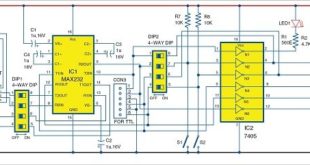The 555 timer IC is used in a variety of timer, pulse generation and oscillator applications. It can be used to provide time delays, as oscillators and as flip-flop elements. The 555 timer IC is an integral part of electronics projects. Be it a simple 555 timer project involving a single 8-bit micro-controller and some peripherals or a complex one involving system on chips (SoCs), 555 timer working is involved. Here, we take a look at some 555 timer circuits based on the IC. For the full list of timer-based projects check out 555 timer projects.
Motion Detector Using NE555 Timer
This circuit is based on a passive infrared (PIR) sensor, which automatically switches on a device when someone comes close to it. It can be used for detection of theft or an unauthorized person entering a restricted area or building. It can also turn on lights when someone approaches the area where it is installed. Applications of this circuit include security systems, corridor lights and bathroom lights among others.
This 555 timer circuit is available at: Motion Detector using NE555 Timer.
Sound Operated Timer
This sound operated timer is based on LM324 quad-operational amplifier and NE555 timer. Time delay can be set from a few seconds to 30 minutes. It can also be used as a sound sensitive burglar alarm. A single side PCB layout for the sound operated timer and its component layout is also provided. After assembling the circuit on the PCB, enclose it in a suitable plastic box.
Set Up a 555 Timer Circuit in Monostable Mode
The 555 can act as either a simple timer to generate single pulses for time delays, or as a relaxation oscillator producing stabilized waveforms of varying duty cycles from 50 to 100%In this tutorial, the presenter will demonstrate how to setup 555 timer circuit in monostable mode. This will allow an LED to be turned on for a specific duration after pressing a button. The time the LED stays on can be changed by changing the resistance and capacitance in the circuit.
555 Timer PWM Audio Amplifier
In this 555 audio PWM project, we explore its use as an astable multivibrator. The ubiquitous 555 timer IC handles audio signals in its own pulse-width modulation (PWM) way. Here, the 555 IC works in astable mode. The switching frequency can be varied from 65 kHz to 188 kHz. Selection of PWM frequency depends on the amplitude of the input signal as well as the load impedance. By adjusting a variable resistance, you can ensure comfortable listening with low audio distortion.
This project is available at: 555 timer PWM audio amplifier.
Sequential Timer for DC Motor Control
a very simple sequential timer can be developed using NE555 ICs wired in monostable mode. Cascading a number of these monostable stages forms a sequential timer. The output of one stage is applied as the trigger to the next stage. So, when the output of a stage drops, it triggers the next stage and the output of the next stage goes high, and likewise the chain reaction starts. Because here the process involves four steps (forward→stop→reverse→stop), four stages of NE555 ICs connected in monostable multivibrator mode are used to form a four-stage sequential timer.
This project is available at: Sequential timer for DC motor control.
Touch-Free Timer Switch
This type of infrared proximity circuit is widely used as an electric switch where physical contact is not desired for hygiene purpose. For example, we commonly see use of infrared proximity sensors on public drinking fountains and in public washrooms. The simple circuit presented here can be operated by moving your hand in front of it. This is achieved by detecting the infrared light reflected by your hand onto a receiver device.
This project is available at: Touch free timer switch.
Linear Timer for General Use
This simple timer can be used to control any electrical appliance that needs to be switched off after certain time, like a small heater or a boiler, provided the relay-switch parameters meet the requirements of that appliance. It uses low-cost components and combines digital precision with simple analogue control, providing long timing duration without the use of high-valued resistors or capacitors.
This project is available at: Linear timer for General Use.
Infrared Remote Control Timer
The circuit comprises two sections, namely, the transmitter section and the receiver section. Fig. 1 shows the IR transmitter section. The astable multivibrator NE555 (IC1) is used to generate a 10kHz modulated IR signal. The output of IC1 is connected to the base of pnp transistor T1 via resistor R2. Two infrared LEDs (IR1 and IR2) are connected in series between the collector (via resistor R3) and ground. When switch S1 is pressed, the IR LEDs transmit the modulated IR signal of 10-11 kHz. This frequency can be changed with the help of VR1 potmeter.
This project is available at: Infrared Remote control timer.
Programmable Industrial On-Off Timer With RF Remote
Some of the features of programmable industrial on/off timer presented here include:
This project is available at: Programmable Industrial On-Off Timer.
Speed Checker for Highways
This speed checker can come in handy for the highway traffic police as it will not only provide a digital display in accordance with a vehicle’s speed but also sound an alarm if the vehicle exceeds the permissible speed for the highway. The system basically comprises two laser transmitter-LDR sensor pairs, which are installed on the highway 100 metres apart, with the transmitter and the LDR sensor of each pair on the opposite sides of the road. The installation of lasers and LDRs is shown in Fig. 1. The system displays the time taken by the vehicle in crossing this 100 meter distance from one pair to the other with a resolution of 0.01 second, from which the speed of the vehicle can be calculated.
This 555 timer project is available at: Speed checker for Highways.
Signal Generator and Inverter Using NE555 Timers
Often we require a squarewave signal generator with adjustable frequency, almost equal high and low output pulses and adjustable amplitudes. Here we present a simple, useful and low-cost signal generator built around NE555 timers. Using external switches, you can control or select frequency ranges as per your requirements. However, use of frequencies below 30kHz is recommended.
This 555 timer project is available at: Signal Generator and Inverter Using NE555 Timers
Demo of 555 timer-based astable multivibrator using MATLAB
In analogue electronics, oscillators and their implementation using integrated circuits (ICs) is an important subject. As 555 timer IC is easy to understand and flexible enough to suit diverse applications, it is used in astable multivibrator (oscillator) configuration for study purpose. While covering the topic in the classroom, instructors often use circuit simulators such as Proteus and TINA to show the output waveform variation of 555 timer IC by changing the resistor or capacitor values.
We present here a demo program for a 555 timer-based astable multivibrator, which is implemented using the graphical user interface (GUI) in MATLAB 2014 environment.
This 555 timer project is available at: Demo of 555 timer-based astable multivibrator using MATLAB
AC Lamp Blinker Using Timer 555
Here we use a very simple and low-cost timer NE555 to switch on and off two output loads alternately for audio and visual indications. You can achieve this by using a bipolar-transistor-based NE555 or CMOS-based LMC555.
This circuit can be made to blink AC lamps at a low frequency, or switch on and off electrical loads connected to the mains at a low speed. In order to reduce the RF emissions, switching is done only at zero crossings of the mains AC voltage.
This 555 timer project is available at: AC Lamp Blinker Using Timer 555
RGB Bulb Using NE555 Timer
Red-green-blue (RGB) multi-colour bulbs available in the market are expensive as these are based on a microcontroller. The program for the microcontroller is difficult to understand. Here is a simple and inexpensive circuit for an RGB bulb using 555 timer.
This 555 timer project is available at: RGB Bulb Using NE555 Timer
False Triggering Eliminator for Timer 555
Normally, false triggering of timer IC 555 takes place during power on, resulting in unwanted output, which starts the timer’s time cycle. The circuit becomes inefficient especially when the load has to be energised only when desired. Here is a simple false triggering eliminator circuit for timer 555.
This 555 timer project is available at: False Triggering Eliminator for Timer 555
Feel interested? Check out our other collection of electronics projects.
This article was first published on 5 November 2017 and was recently updated on 15 December 2018.








